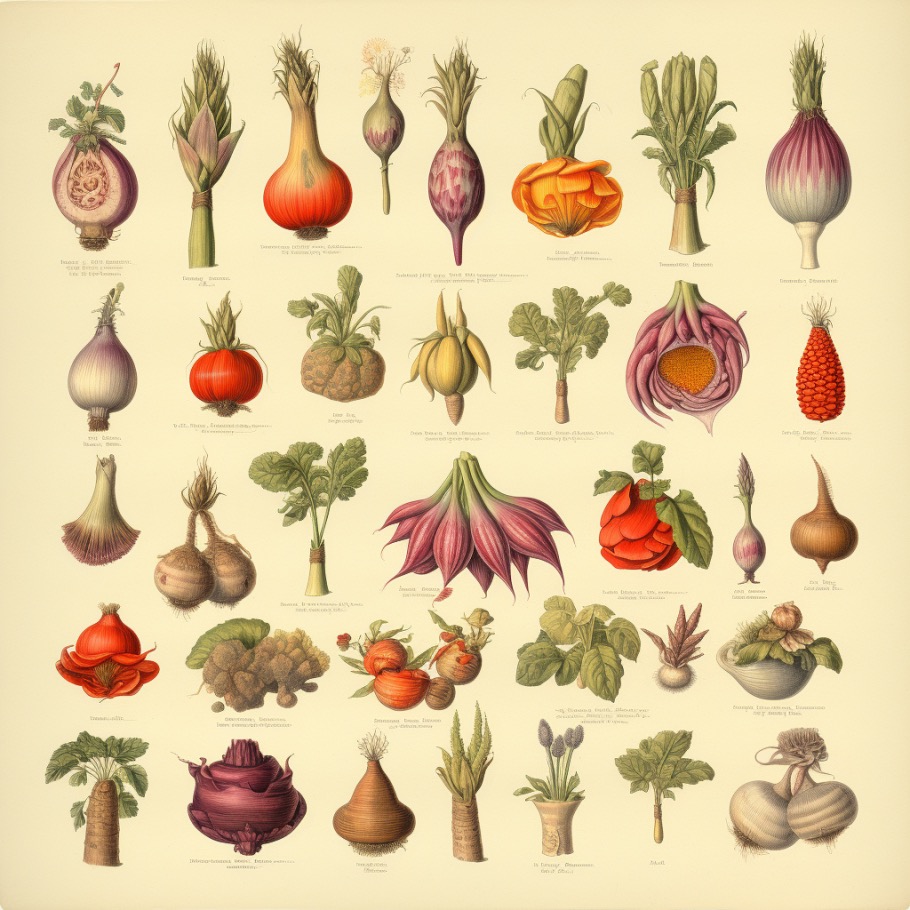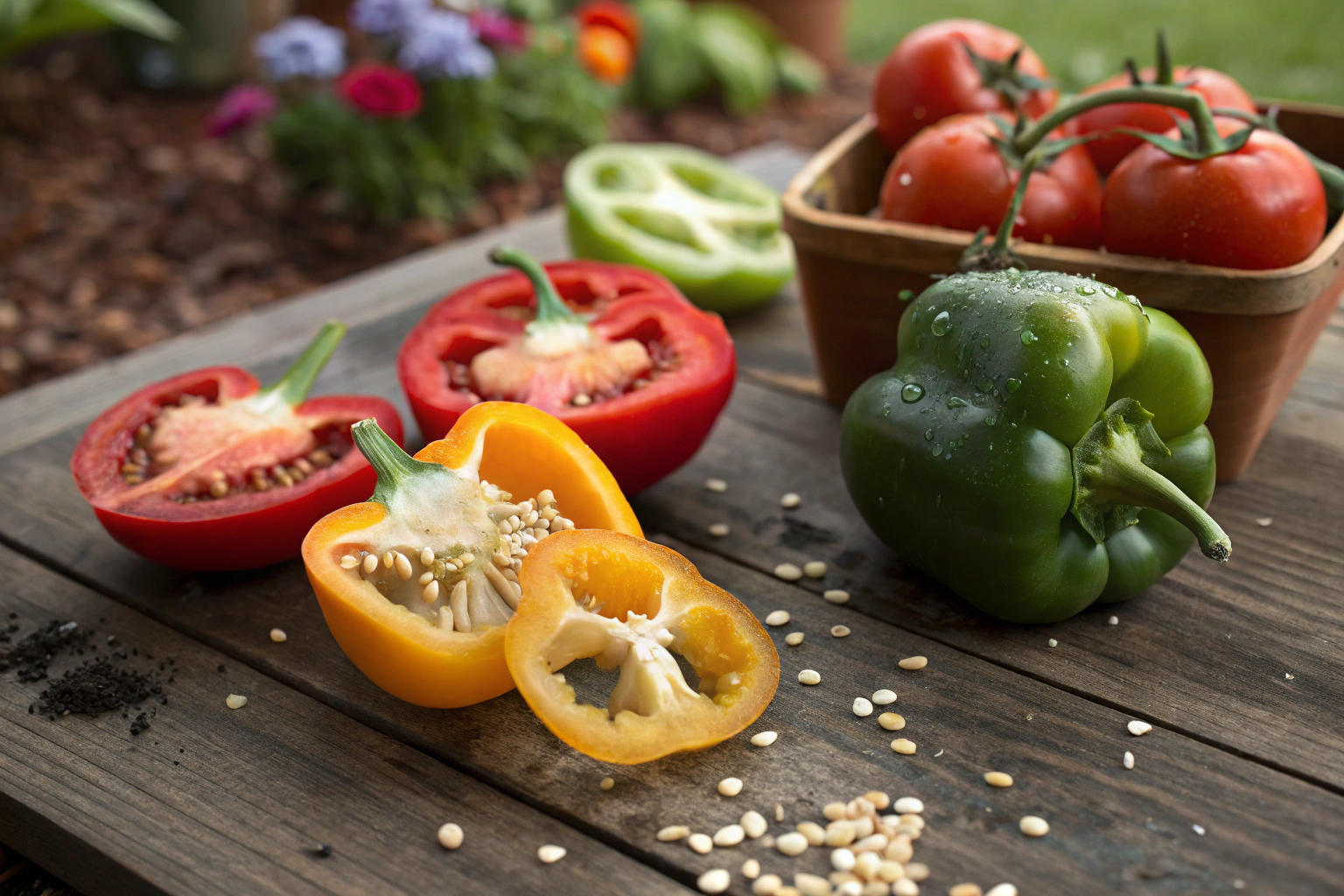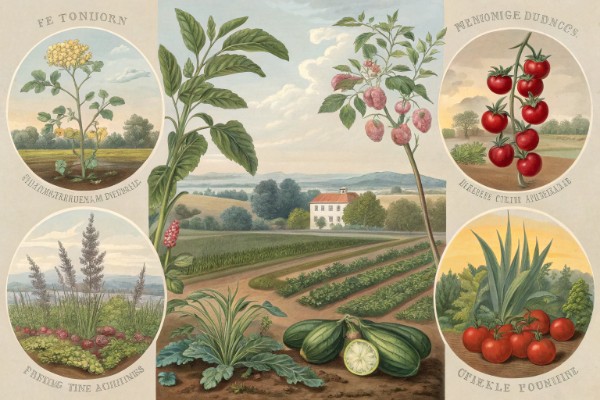Do Vegetables Have Seeds? A Gardener's Guide to Produce

Do Vegetables Have Seeds?
Do vegetables have seeds? Slice open a ripe cucumber, zucchini, or tomato and see tiny seeds staring back—proof that many garden vegetables do carry seeds. Yet pull a carrot or radish from the soil, and you'll find no seed inside, demonstrating how some vegetables reproduce differently. Keep reading to decode the quirks of your backyard produce and better understand what's growing beneath your fingertips.
Cheatsheet: Seed Clues in Your Veggies
🌱 Seed Basics
- Fruit vegetables (tomato, pepper, cucumber, squash, eggplant): seeds inside, edible fresh, botanically fruits.
- Root, stem, leaf vegetables (carrot, beet, celery, lettuce): no seeds in edible part; seeds form if plant bolts (flowers).
- One bell pepper yields 30–50 seeds; carrots: 1,000+ per umbel.
🍅 Common Veggies With Seeds
- Tomato, cucumber, bell pepper, squash, pumpkin, okra, eggplant, pea, bean
- Harvest seeds when fruits are fully ripe/mature
🥕 Seedless Veggies & Exceptions
- Carrot, radish, lettuce, spinach: no seeds inside edible part
- Seedless varieties (e.g., English cucumber) grown by hybridization
💡 Save Seeds for Self-Sufficiency
- Non-hybrid, open-pollinated types allow seed-saving
- Dry seeds thoroughly; store at 40°F/4°C, dark spot
- Viable seeds can boost your food security
🥗 Freshness & Nutrition
- Produce with seeds tends to be richer in fiber
- Fresh-picked vegetables supply higher nutrient content
🛠️ Tools and Products You’ll Need
- Heirloom/non-GMO seeds
- Sterile seed-starting mix
- Food-safe storage envelopes
- Sharp knife or scoop
- Fine mesh sieve
- Labeling pen
- Glass jar (for fermenting tomato/cuke seeds)
📝 Step-by-Step: Collecting Seeds
- Pick vegetables at full ripeness; overripe for best seed maturity.
- Cut produce, scoop out seeds, separate from pulp.
- Clean seeds (water rinse or ferment if needed).
- Dry on parchment or mesh at room temperature (68–75°F / 20–24°C) for 5–10 days.
- Store seeds in labeled, airtight packets in cool, dry conditions.
Do Vegetables Have Seeds? Clearing Up Your Garden’s Great Mystery
On a humid July afternoon, picking ripe tomatoes off sun-warm vines, my nephew asked the puzzling question—"do vegetables have seeds, too?" I paused mid-pick, struck by the sheer innocence and surprising complexity of what he'd asked.
To truly answer him (and perhaps settle family arguments at your dinner table, too), let's unpack the botanical definitions and gardening lore of vegetable seeds.
The Botanical Truth: Vegetables vs. Fruits
Botanists classify "fruits" as the part of the plant that houses seeds, developing from flowers after pollination. That's nature's clever reproductive strategy.
On the other hand, "vegetables" represent edible plant parts—the leaves, stems, roots, and tubers—that don't house seeds directly.
"Botanically speaking, anything containing seeds is technically a fruit."
This blew my nephew's mind, understandably confusing his tidy impressions of garden categories. After all, this meant cucumbers, eggplants, pumpkins—even peppers—count botanically as fruits.
Common "Vegetables" with Seeds: A Botanical Twist
- Tomatoes: Juicy, seed-packed, they're gardeners' poster children for botanical fruit status.
- Cucumbers: Crisp and refreshing, cucumber seeds hide in watery centers, signaling clear fruit identity.
- Bell Peppers: Their colorful exteriors conceal clusters of tiny seeds, undeniably categorizing them as fruits.
- Squash & Pumpkins: Slice open these autumnal beauties, and satisfyingly plump seeds spill out in abundance.
Meanwhile, leafy greens like spinach or kale, root veggies (hello radishes and carrots), and savory bulbs such as onions and garlic yield no seeds within their edible parts.
The Curious Case of Seedless Produce
Seedless cucumbers and grapes might seem like a botanical paradox. I once experimentally grew "seedless" cucumbers, a tricky game requiring specialized hybrid varieties bred for sterility or tiny, underdeveloped seeds.
This seedlessness results from sterile hybrids or selective breeding—not nature abandoning its reproductive principles.
Harvesting Vegetable Seeds at Home
Saving seeds from fruit-producing vegetables like peas, beans, and tomatoes feels like pocketing treasure from your garden's bounty. I recall scooping ripe tomato seeds onto paper towels, air-drying them in shady corners, and feeling like a modern-day alchemist.
For newbies in seed-saving adventures, some guidelines can streamline the process:
- Harvest seeds from fully ripe, disease-free produce to ensure viable offspring.
- Clean, dry, and label clearly to prevent confusion later. I've mistaken tomato varieties before—leading me into tasty but unexpected gardening surprises.
- Store seeds in airtight containers in cool, dark spots—around 40°F (4°C) being ideal.
"Properly stored vegetable seeds can remain viable for 2–5 years, making your gardening efforts richly rewarding over multiple seasons."
Heirlooms, Hybrids, and the Seed-Saving Debate
Heirloom vegetables, preserved through generations by gardeners themselves, faithfully reproduce true to their parent plants. Hybrids, the product of deliberate crosses, sometimes produce unpredictable offspring—yet can amaze with delightful variations.
Testing hybrid seeds carries a sense of playful discovery, though heirlooms remain trusty staples for long-term seed-saving.
Clarifying Vegetable Seed Confusion: Final Takeaways
- Fruit-producing "vegetables", botanically fruits, contain seeds—think tomatoes, peppers, cucumbers.
- True botanical vegetables—roots, tubers, bulbs, leaves—grow without seeds within their edible parts.
- Seedless varieties arise from human intervention rather than natural preference.
Understanding these nuances deepens garden appreciation and sparks conversations around dinner tables and backyard barbecues alike. Gardening remains not merely cultivating earth but reshaping our perspectives and challenging what we think we know.
That day spent among tomatoes, I realized gardening wisdom sprouts precisely in these small yet intriguing revelations—like the simple yet complex question my nephew posed, forever reshaping his (and my own) perception of backyard bounty.
Vegetable Seed FAQs: Understanding Your Garden's Produce
Which common vegetables contain edible seeds?
Many garden vegetables carry edible seeds—examples include peas, beans, corn, and peppers. These seeds serve as nourishing proteins, nutrients, and flavors enhancing culinary dishes.
Which vegetables produce seeds but we typically avoid eating them?
Commonly cultivated vegetables like eggplants, cucumbers, zucchinis, and pumpkins produce visible seeds. While edible, these seeds often yield bitter textures or flavors, encouraging gardeners to remove or discard them during food preparation.
Can gardeners save vegetable seeds directly from harvested produce for future planting?
Seed saving provides gardeners with sustainability and consistency. For accurate preservation, select mature, healthy plants producing true-to-type seeds, dry thoroughly, and store in cool, dry conditions (around 40°F or 4°C) for optimal germination in future planting seasons.
Do root vegetables like carrots or potatoes produce seeds?
Carrots bloom small flowers in their second growing year, producing viable seeds for planting. Conversely, potatoes primarily propagate through seed potatoes (tuber sections) rather than actual botanical seeds, as true potato seeds rarely match parent plant characteristics.
Are seedless vegetables natural or genetically modified?
Seedless vegetables, such as certain cucumbers or watermelons, result naturally from selective plant breeding and hybridization methods—no genetic modification involved. Gardeners raising seedless varieties require seeds from specialized suppliers, as these plants do not self-propagate.
Do vegetables have seeds? Most of what we call vegetables—like tomatoes, peppers, cucumbers, and squash—absolutely do, hiding them right in plain sight. Others, like carrots and lettuce, are harvested before their seeds even form. Knowing this helps you save seeds, plan future crops, and really get a grip on how your vegetable garden ticks. If you’re aiming for raised beds or containers, some seed-filled vegetables are easier to manage—have a look at these easy vegetables to grow in raised beds or tips for growing onions in containers. Whether you’re after flavor, yield, or just more control over your food, understanding which vegetables have seeds puts you one step ahead. The dirt under your nails? That’s just part of the story.
Health Benefits of Seeded vs. Seedless Vegetables
Fiber and Digestion
- Seeded produce, such as cucumbers and tomatoes, contains soluble and insoluble fiber improving gut health and regularity.
- Example: Tomato seeds offer dietary fiber beneficial for digestion and cholesterol control.
Concentration of Nutrients
- Produce seeds contain concentrated micronutrients, antioxidants, and essential fatty acids.
- Example: Pumpkin seeds deliver zinc, magnesium, healthy fats, and anti-inflammatory compounds to support immunity and heart health.
Blood Sugar Regulation
- Vegetable seeds supply compounds aiding stable blood glucose, positively influencing insulin sensitivity.
- Example: Bitter melon seeds demonstrate compounds studied for glycemic control properties.
Cholesterol and Heart Health
- Seeds within vegetables offer phytosterols and essential fatty acids beneficial for cardiovascular wellness.
- Example: Zucchini seeds provide omega-3 fats, potassium, and carotenoids helpful in healthy blood pressure management.
Self-Sufficiency and Sustainability
- Growing seed-rich produce allows gardeners self-reliance through seed saving, lowering gardening expenses.
- Fact: Saving seeds annually can decrease seed-purchasing costs by 60%–80%.
Find out which plants will thrive in your garden!
Answer a few fun questions and get custom plant recommendations perfect for your space. Let’s grow something amazing together!

start your season






